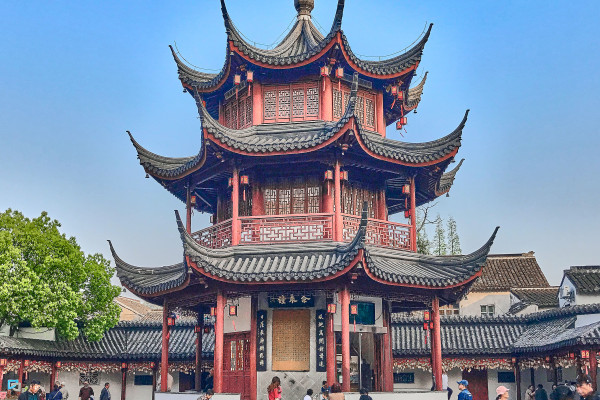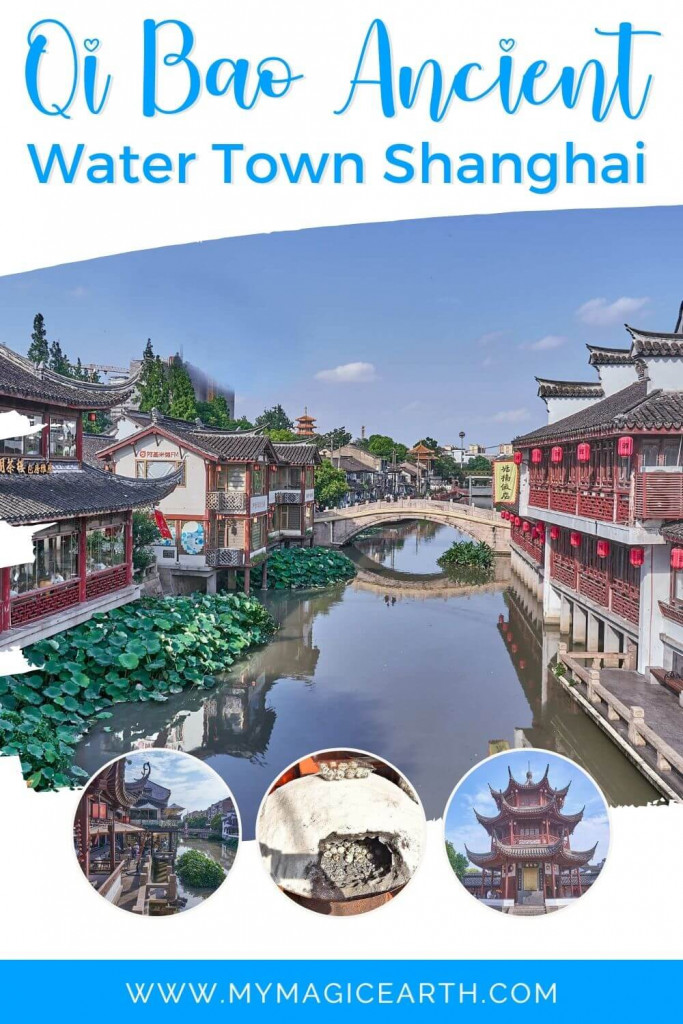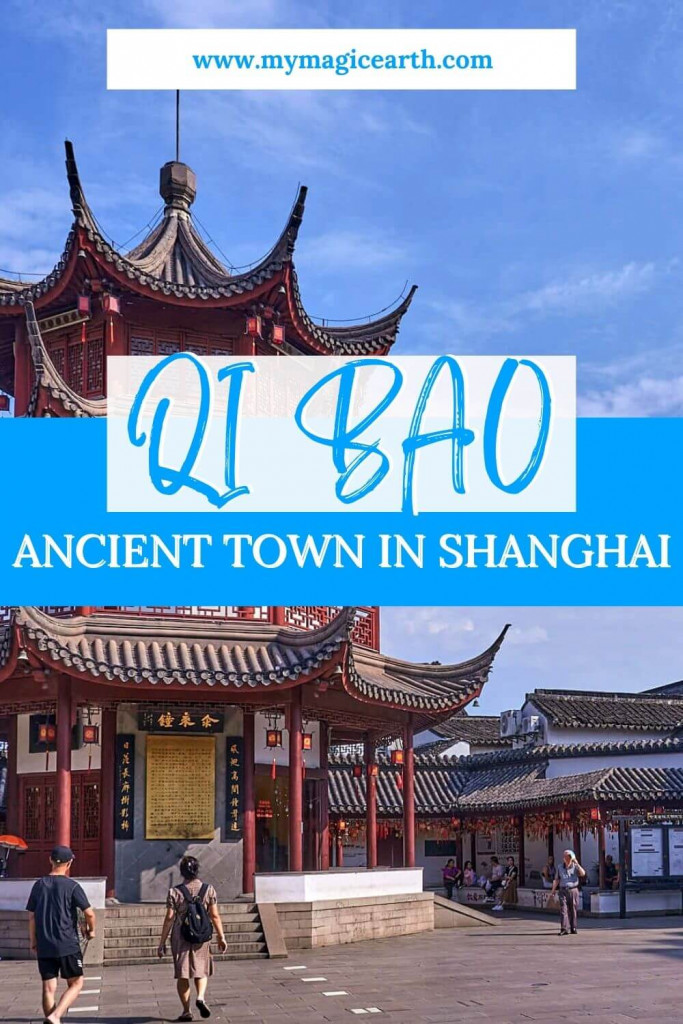Nestled within Shanghai, Qibao Ancient Water Town (七宝古镇) boasts a rich history dating back to the Northern Song Dynasty (960-1127) and flourished during the Ming Dynasty (1368-1644), making it a thousand-year-old gem.
The name ‘Qibao’ translates to ‘seven treasures’ in Chinese. Two prevailing theories surround its origin. The most widely accepted theory suggests it derives from the renowned Qibao Temple, which significantly contributed to the town’s prosperity and cultural development. Another local idea revolves around a folktale about seven treasures, though only four are confirmed, and just two have survived.
Among other water towns in Shanghai, Qibao Ancient Water Town holds a special place in my heart, not just because of its history and lively atmosphere. My personal connection with this charming place is deeply rooted in my childhood memories. When I was a child, I loved the local snacks and especial pickled vegetables here. Everytime I visited my parents’ home in Shanghai, I would go to Qibao to relish these nostalgic tastes and relive my childhood. The aroma of street food and the bustling scenes on Qibao Old Street always bring back warm memories. Strolling beneath the eaves of the historic buildings, I can truthfully sense the glorious past of this place.



The unique places of interest
Qibao Ancient Water Town boasts a variety of tourist sites for you to explore. Starting at the entrance, you’ll find the renowned Qibao Temple, a significant Buddhist temple in the area.
As you stroll through the town, you’ll come across three charming stone bridges: Kangle Bridge, Puhui River Bridge, and Anping Bridge. Each of these bridges adds to the town’s picturesque charm.
In addition to Qibao Old Street, there are many cultural attractions within Qibao Ancient Water Town, such as the Shadow Puppet Art Museum, Zhang Chongren Memorial Hall, Cricket Cottage, Zhou’s Microcarving Museum, Qibao Winery, Bell Tower, Qibao Taoist Temple, and other scenic spots. Furthermore, the ancient town is also home to some lifelike wax figures of historical figures.
Now, let’s dive into the heart of Qibao Ancient Water Town – Qibao Old Street (七宝老街). Divided into two parts, North Street and South Street, it offers a unique shopping and dining experience. North Street is a hub for arts, crafts, calligraphy, and souvenirs, while South Street specializes in mouthwatering local cuisine. Qibao Old Street (七宝老街) is also one of the famous food streets in Shanghai.


Local foods you could try
Qibao is a treasure trove of traditional foods and snacks, with local shops offering various delights. You’ll find classics like Fried Stinky Tofu (油炸臭豆腐, You Zha Chou Dou Fu), tender Slices of Lamb Meat (白切羊肉, Bai Qie Yang Rou), and flavorful Braised Pork (酱猪蹄, Jiang Zhu Ti). Most of these shops are quaint and cozy, and their open kitchens provide a captivating view of the skilled chefs preparing these treats right before your eyes
Among the locals’ favorites are:
- Glutinous Rice Balls (老街汤圆, Lao Jie Tang Yuan)
- Salt Baked Quail Eggs (盐焗鹌鹑蛋, Yan Ju An Chun Dan)
- Beggar’s Chicken (叫化鸡, Jiao Hua Ji)
- The irresistible Sugar-coated Hawthorns (糖葫芦, Tanghulu)


Glutinous Rice Ball (老街汤圆, Lao Jie Tang Yuan)
Glutinous rice balls, known as Tang Yuan, hold a special place in the hearts of Shanghainese. These delectable treats come with various fillings, including sesame paste, peanut paste, or minced meat.
Crafting Tang Yuan is an art that requires skill. Visitors may even have the chance to observe the skilled staff making them. The process begins by flattening a dough and gently pinching it in the middle. The desired filling, such as sesame, is carefully placed in the center before closing the dough, and shaping it into round balls through gentle rolling.
Tang Yuan’s pastry is wonderfully soft and chewy. When you take a small bite, the rich sesame flavor blends with the luscious aroma of lard, creating a delightful sensation on your palate. As you savor the treat, the sweetness of the filling bursts into a symphony of flavors. However, be cautious of the hot liquid fat inside, as it can melt and lead to an unexpected burn.
If you visit Yu Garden in Shanghai, you’ll also find these delightful glutinous rice balls served in the traditional restaurants nearby. It’s an experience you won’t want to miss.


Salt Baked Quail Eggs (盐焗鹌鹑蛋, Yan Ju An Chun Dan)
While exploring, keep an eye out for stalls selling salt-baked quail eggs. These stalls typically showcase small nests crafted from a mixture of salt and gypsum, where quail eggs are nestled in abundance. For just a few Chinese yuan, you can purchase an entire box of these eggs, ready to be savored without additional cooking.
Beggar’s Chicken (叫化鸡, Jiao Hua Ji)
The process of preparing a Beggar’s Chicken is quite intricate. There are various versions of the story behind it. Legend has it that in a village in Changshu County, Jiangsu Province, a beggar once caught a chicken but lacked cooking utensils and seasonings.
In frustration, he slaughtered the chicken, removed its internal organs, and coated it with mud. He then piled up some dried leaves and set them on fire to roast the chicken. By the time the clay had dried, the chicken was cooked and ready to eat. The beggar broke open the mud shell, plucked the chicken’s feathers, and was overjoyed when he caught a delightful aroma. He devoured the chicken with lightning speed, and the locals have cherished this recipe ever since.
Sugar-coated haws (糖葫芦, Tanghulu)
Tanghulu, also known as Bingtanghulu (冰糖葫芦), is a classic Chinese treat crafted from candied fruit. It features a crunchy sugar coating obtained by dipping the fruit skewer in sugar syrup. While traditional Tanghulu uses Chinese hawthorn fruit, modern versions include strawberries, pineapples, kiwifruit, and bananas.


Travel Tips
Where to stay
A high-end hotel, Le Meridien Shanghai Hongqiao, Minghang, is conveniently situated within walking distance from Metro Line 9.
Metro Line 9 offers easy access to numerous attractions in the city center, making Qibao an excellent choice for accommodation when visiting Shanghai.
How to get to Qibao ancient water town
By Metro: Board Shanghai metro line 9 and disembark at Qibao (七宝) station, located within a modern shopping mall. Exiting the mall from exit 2, it’s a pleasant 5 to 10-minute stroll to reach Qibao Ancient Water Town.
By Bus: Opt for bus routes 87, 91, 92, 186, 189, 196, 198, 709, 735, 748, 803, Hongqiao Hub Line 4 (虹桥枢纽4路), Husong Line (沪松线), or Minhang Line 33 (闵行线33) and alight at Qibao Station.
Upon leaving Qibao Subway Station on Line 9, head south along Minzhu Road (民主路). At the T-junction, take a left and continue east along Qingnian Road (青年路). You’ll soon encounter the entrance marked by an archway with the bell tower in the background.



